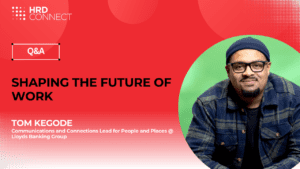Tech is the future of talent: a conversation with Speakap
- 5 Min Read
Patrick Van Der Mijl, Co-Founder and Chief Product Officer, Speakap, talks to HRD Connect about the challenges facing HR and how technology is helping to solve them. Why was it necessary to create Speakap? That’s an interesting question and it’s something I actually witnessed first-hand. While attending university in the Netherlands, Erwin Van Der Vlist […]
- Author: Michael Hocking
- Date published: Mar 18, 2019
- Categories

Patrick Van Der Mijl, Co-Founder and Chief Product Officer, Speakap, talks to HRD Connect about the challenges facing HR and how technology is helping to solve them.
Why was it necessary to create Speakap?
That’s an interesting question and it’s something I actually witnessed first-hand. While attending university in the Netherlands, Erwin Van Der Vlist (Speakap co-founder) and I were working part-time in a supermarket. We experienced directly how manual, fragmented, ineffective and confusing the style and quality of communications was from our employer to those of us working on the frontline.
The supermarket managers were still posting printed notes on bulletin boards about important price changes, new (or discontinued) product offerings or promotions and sales. We knew how poor, irrelevant and ineffective communications impacted employee productivity levels, job performance and job satisfaction and we also knew we wanted to create a new platform that could solve these problems.
Why is HR technology important for the success of a business?
Talent is increasingly becoming the major competitive advantage in the marketplace and a driver of bottom-line success. If HR is the business of attracting and retaining top-notch talent, having a highly-competent suite of HR technologies is key to scaling those capabilities.
Technology can scale the employee experience and lead to higher employee satisfaction and, therefore, productivity. But HR tech also plays a massive role in reducing the silent expenses – such as high employee turnover due to poor communications, onboarding and training – and the associated costs that come with the constant need to search for, interview and onboard new employees. Both of these have a real, measurable impact on company reputation and business success.
How can HR integrate technology into its function without losing the human element?
I actually don’t see it that way at all. For me, successful integration of HR technology helps organisations to increase the human element. For many of our clients in the retail, hospitality and entertainment sectors, we help them unite their frontline employees across hundreds, and even thousands, of stores around the world, thus empowering them to share tips, tricks and best practices with their colleagues, which improves their productivity, job performance and overall job satisfaction. It also helps senior management speak to and get feedback from employees at all level of the company.
If technology can facilitate some of the more process-driven mundane HR processes, it lets HR focus more on delivering a delightful, personalised and human employee experience.
Why is acquiring and implementing HR technology such a pain point for many businesses? How can this be addressed?
I don’t think acquiring HR technologies is such a pain point – other than the fact that there are a lot of great tools out there and it’s important to find the right one to solve your specific business challenges. But the post-contract signing implementation phase, whereby execution can be complex, is a critical period. If a new software isn’t implemented properly and the teams responsible for the daily use and internal implementation aren’t trained properly on how to use and roll it out, it can lead to the software failing to stick.
Implementing new software can be really tricky; it requires a lot of different processes and involves many stakeholders, usually across a range of different departments, all of whom need to coordinate and collaborate to get the most out of the software.
To make our customers successful in implementing Speakap, we have customer success managers whose entire role is focused on just this. In their experience, you really need to have senior level buy-in to make a platform stick, as well as removing any other ‘unofficial’ shadow IT that might conflict with the purpose of your designated tools.
Which technologies do you think could disrupt or transform HR for the better?
There are two huge trends that I see disrupting and shaping HR in the next few years. The first is people analytics. People analytics and data can be a vital way to get those insights into employees’ engagement patterns and communications behaviors.
HR teams can also integrate survey tools, such as Hyphen, SurveyMonkey and Qualtrics, into their employee communications platform to make it easier, quicker and more efficient to survey employees in real-time about their job satisfaction, culture alignment and overall employee experiences. This will surely speed up the feedback loop between employees and management and potentially improve the relationship between hourly/non-desk workers and management.
The second HR trend is the consumerization of the workplace. The cutting-edge, innovative apps and technologies that employees use every day in their personal lives are seeping into the workplace where – with a few exceptions – we’re still using old-fashioned, unintuitive systems for payroll, communications, sharing files, measuring results. Nowadays, it’s quicker and easier to open a bank account, book a holiday or sign up to a course than it is to find your salary statement, request time off or access the company’s learning portal. That’s already started to change, but will change even more significantly and even faster in the next few years.
What role will technology play in HR in the future?
As technology enables HR, we’re going to see boundaries between departments continue to blur: for example, the spaces between HR, Internal Comms, Marketing and even IT are getting closer and closer.
Much like the marketing technology revolution a decade ago, the HR tech stack is also forcing HR to start measuring and justifying its ROI as a function. This may come as a shock to those who’ve been in HR a long time, but being able to demonstrate the dollar value of HR to the broader company is also going to give senior HR directors a seat at the table and increased strategic decision-making power.











